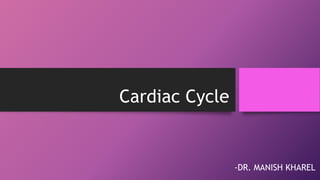
Cardiac cycle
- 1. Cardiac Cycle -DR. MANISH KHAREL
- 2. What is actually a cardiac cycle? • The cardiac cycle is defined as a sequence of alternating contraction and relaxation of the atria and ventricles in order to pump blood throughout the body. In normal person, one cardiac cycle time is about 0.8 seconds. (MCQ) • It starts at the beginning of one heartbeat and ends at the beginning of another. • Each cardiac cycle has a diastolic phase (also called diastole) where the heart chamber is in a state of relaxation and fills with blood that receives from the veins and a systolic phase (also called systole) where the heart chambers are contracting and pumps the blood towards the periphery via the arteries. • Both the atria and the ventricles undergo alternating states of systole and diastole. In other words, when the atria are in diastole, the ventricles are in systole and vice versa.
- 3. Phases of cardiac cycle Diastole (when the heart fills with blood) Atrial diastole Ventricular diastole Systole (when the heart pumps the blood) Atrial systole Ventricular diastole
- 4. Atrial diastole • Atrial diastole is the very first event of the cardiac cycle. (MCQ) • During atrial diastole, blood enters the right atrium through the superior and inferior vena cava and the left atrium via the pulmonary veins. • In the early part of this phase, the atrioventricular valves are closed and blood stays in the atria. • In the late part of this phase, there comes a point when the pressure in the atrium is greater than the pressure in the ventricle. This pressure difference results in the opening of the atrioventricular valves, allowing blood to flow into the ventricle.
- 5. Atrial systole • The sinoatrial node (SA node) initiates an action potential that is propagated (passed) throughout the atrial myocardium. • The electrical depolarization results in simultaneous contraction of the atria, thus forcing the blood from the upper chambers into the lower chambers of the heart.
- 6. Ventricular diastole • During the early stages of ventricular diastole, both the atrioventricular and semilunar valves are closed. During this phase, there is no change in the amount of blood in the ventricle, but there is a precipitous (sudden) fall in the intraventricular pressure. This is known as isovolumetric relaxation. • Eventually, the ventricular pressure becomes less than the atrial pressure, and the atrioventricular valves open. This results in filling of the ventricles with blood, which is often referred to as the rapid filling of the ventricles. • Towards the end of ventricular diastole, any residual (remaining) blood in the atria is pumped into the ventricle. The total volume of blood present in the ventricle at the end of diastole is called the end-diastolic volume (110-120ml) or preload. (MCQ)
- 7. Ventricular systole • Ventricular systole refers to the period of contraction of the ventricles. • As the ventricle begins to contract, the pressure exceeds that of the corresponding atrium, resulting in the closure of the atrioventricular valves. At the same time, the pressure is not sufficient to open the semilunar valves. Therefore, the ventricles are in a state of isovolumetric contraction – as there is no change in the overall volume (end-diastolic volume) in the ventricle. • As the ventricular pressure exceeds the pressure in the outflow tract, the semilunar valves open, allowing blood to leave the ventricle. This is the ejection phase of the cardiac cycle. • The amount of blood left in the ventricle at the end of systole is known as the end-systolic volume (afterload, between 40 – 50 ml of blood). (MCQ) • The amount of blood actually ejected from the ventricle is known as the stroke volume . • The ratio of the stroke volume output to the end-diastolic volume is called the ejection fraction and usually amounts to around 60%. (MCQ) • The ventricles re-enter in a state of isovolumetric relaxation and the atria continue to fill. The process starts over and continues to repeat for as long as the individual is alive.
- 8. Key Facts of Cardiac Cycle Atrial diastole Atria passively filling Atrioventricular valves open Atrial systole Action potential from the sinoatrial node (SAN) Synchronous (at the same time) atrial contraction Active filling of ventricles Ventricular diastole Action potential from the sinoatrial node (SAN) Synchronous (at the same time) atrial contraction Active filling of ventricles Ventricular systole Isovolumetric contraction – atrioventricular and semilunar valves are closed Semilunar valve opens Emptying of the ventricle End-systolic volume
- 9. Cardiac Output and Stroke Volume Cardiac output : • It is the total volume of blood pumped by the heart per minute. • It is about 5-6 L/min. (MCQ) Stroke volume : • It is the volume of blood pumped by the heart in each cardiac cycle. • It is about 70-80 ml. (MCQ) • Stroke Volume is the difference between end diastolic volume (EDV) and end systolic volume (ESV).
- 10. Relationship between Stroke Volume and Cardiac Output • Cardiac Output = Stroke Volume x Heart Rate CO = SV x HR = 70 ml x 72/min = 5040 ml/min = 5.04 l/min • But as the heart rate varies it is usually in between (5-6 l/min)
- 11. Factors regulating Cardiac Output 1. Venous Return : It is the flow of blood back to the heart. Increase in venous return increases the cardiac output. 2. Force of contraction of heart : Increase in force of contraction increases the CO. 3. Frequency of heartbeat (Heart Rate) : Cardiac output increases with increased heart rate. 4. Ejection Fraction : The ratio of the stroke volume output to the end-diastolic volume is called the ejection fraction and usually amounts to around 60%. 5. Total peripheral resistance : Cardiac output increases with the decrease in peripheral resistance.
- 12. Have a nice day!
